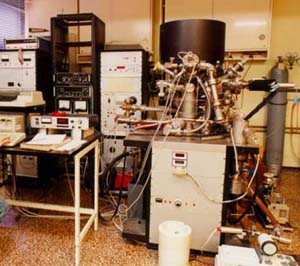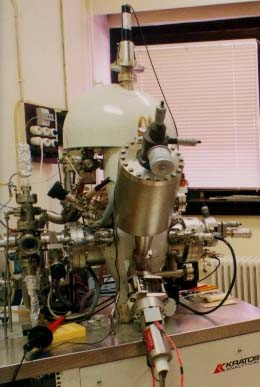Instrumental Background
1. Catalyst Characterization Techniques
1.1. Temperature Programmed Spectroscopy
It comprises methods such as in flow system temperature programmed reduction (TPR), chemisorption and temperature programmed desorption (TPD) of hydrogen, oxygen and CO to characterise surface metallic sites. In atmospheric flow system using TCD and QMS detectors, all these methods are computer controlled and routinely used. Processes such as oxidation, reduction, adsorption, desorption, decomposition and any other reactions investigated in the temperature programmed mode are measured by means of a new, computer and QMS aided system developed here and called SORBSTAR.
1.2. Photoelectron Spectroscopy
1.2.1. ES-300- for model catalystsES-300 photoelectron spectrometer is used for X-ray photoelectron spectroscopy (XPS), UV-photoelectron spectroscopy (UPS) and Auger electron spectroscopy (AES). The apparatus is equipped with dual anode X-ray source (AlKa and MgKa), He (I) and He (II) UV source and Auger gun. Static or rastering argon ion guns with different energies are applied for sample cleaning. An in situ atmospheric pressure reaction chamber is attached to the apparatus for treatment of catalyst in reaction mixture or in various gases. The gas composition during measurements is monitored by quadrupole mass spectrometer.

KRATOS instruments type XAMSpci is applied for more sophisticated high performance XPS measurements. This XPS is equipped with two X-ray sources, one is the conventional dual anode system and the other is equipped with a monochromator. The monochromatic X-ray has a much narrower energy range; thus satellite and EEL peaks can be reduced. The machine is equipped with flood gun for charge neutralization, XYZ manipulator and a rastering minibeam system for sample cleaning. An atmospheric reaction chamber is attached for in situ catalytic works. working under UHV condition. The main chamber includes AES and LEED optics, XYZ heatable manipulator, argon ion gun, QMS, transfer capsule and various sample manipulator roads. The main chamber is connected by gate valve to an other chamber equipped with RHK STM head. The transfer capsule makes possible to develop a network of STM - XPS for a comprehensive analysis of practical samples.

1.3. Fourier Transform Infrared Spectroscopy
A Midac M2010H FTIR spectrometer equipped with operating software consisting of Spectra of Spectra Calc package is available for IR spectroscopy. The spectrometer is equipped with diffuse reflectance accessory and environmental chamber. For the transmission mode an in situ catalytic flow cell working under controlled temperature (maximum 800K) and atmosphere is used.
2. Catalytic Apparatus
For kinetic purpose all-glass made circulation batch reactors is applied linked to on-line GC or QMS systems. Here a maximum of 0.5 g catalyst sample can be investigated.
Plug flow tubular, integral reactor operating under atmospheric pressure provided by gas mass flow controllers, GC and QMS analysis, is a frequently used unit. The units are coupled to computers for data acquisition. In some units in situ characterisation of the catalysts is also possible by pulse chemisorption and temperature programmed spectroscopies (TPD TPR, TPO). One unit is used in transient kinetic studies. A pressurised reactor under medium pressure range (1-40 bar) is applied for performing experiments near to real conditions to measure continuously catalyst deactivation, pressure dependence, etc.
To measure routinely total oxidation of hydrocarbons a semi-automatic device is used equipped with IR cells for CO and CO2 measurements. All equipment is connected on line to computers.
High pressure reactors for working in gas and liquid phase.
High pressure liquid chromatograph (HPLC) is available for analysis of liquid reaction products.
3. Experiments with Labelled Materials
The experimental methods involve pulse, atmospheric single pass, low pressure static circulation and high pressure flow reactors in which labelled experiments can be carried out using deuterium, 13C, 14C and 35S labelled substances.

